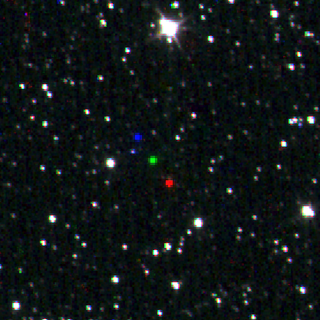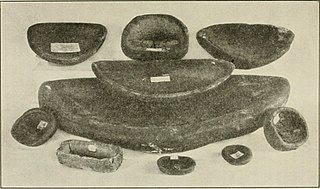
The Aleuts, who are usually known in the Aleut language by the endonyms Unangan, Unangas, Унаӈан, are the indigenous people of the Aleutian Islands.

The walrus is a large flippered marine mammal with a discontinuous distribution about the North Pole in the Arctic Ocean and subarctic seas of the Northern Hemisphere. The walrus is the only living species in the family Odobenidae and genus Odobenus. This species is subdivided into two subspecies: the Atlantic walrus, which lives in the Atlantic Ocean, and the Pacific walrus, which lives in the Pacific Ocean.

Marine mammals are aquatic mammals that rely on the ocean and other marine ecosystems for their existence. They include animals such as seals, whales, manatees, sea otters and polar bears. They are an informal group, unified only by their reliance on marine environments for feeding and survival.

Pinnipeds, commonly known as seals, are a widely distributed and diverse clade of carnivorous, fin-footed, semiaquatic, mostly marine mammals. They comprise the extant families Odobenidae, Otariidae, and Phocidae. There are 34 extant species of pinnipeds, and more than 50 extinct species have been described from fossils. While seals were historically thought to have descended from two ancestral lines, molecular evidence supports them as a monophyletic lineage. Pinnipeds belong to the order Carnivora; their closest living relatives are bears and the superfamily of musteloids, having diverged about 50 million years ago.

Inuit religion is the shared spiritual beliefs and practices of the Inuit, an indigenous people from Alaska, Canada, and Greenland. Their religion shares many similarities with some Alaska Native religions. Traditional Inuit religious practices include animism and shamanism, in which spiritual healers mediate with spirits. Today many Inuit follow Christianity, but traditional Inuit spirituality continues as part of a living, oral tradition and part of contemporary Inuit society. Inuit who balance indigenous and Christian theology practice religious syncretism.

Sedna is the goddess of the sea and marine animals in Inuit mythology, also known as the Mother of the Sea or Mistress of the Sea. The story of Sedna, which is a creation myth, describes how she came to rule over Adlivun, the Inuit underworld.
The Adlet are a race of creatures in the Inuit mythology of Greenland, as well as the Labrador and Hudson Bay coasts. While the word refers to inland native American tribes, it also denotes a humanoid dog-legged tribe. The lower part of the body of the canine Adlet is like that of a dog and their upper part is like a man's. All Adlet run quickly, and their encounters with men usually end with man as the victor.

Siberian Yupiks, or Yuits, are a Yupik people who reside along the coast of the Chukchi Peninsula in the far northeast of the Russian Federation and on St. Lawrence Island in Alaska. They speak Central Siberian Yupik, a Yupik language of the Eskimo–Aleut family of languages.

Siarnaq, also designated Saturn XXIX, is a prograde irregular satellite of Saturn. It was discovered at the Mauna Kea Observatory by astronomers Brett Gladman and John Kavelaars in 2000, and given the temporary designation S/2000 S 3. It was named after Siarnaq, more widely known as Sedna, the Inuit goddess of the sea, and is the largest member of Saturn's Inuit group of irregular satellites.

The Inuit angakkuq Inuvialuktun: angatkuq; Greenlandic: angakkoq, pl.angákut) is an intellectual and spiritual figure in Inuit culture who corresponds to a medicine man. Other cultures, including Alaska Natives, have traditionally had similar spiritual mediators, although the Alaska Native religion has many forms and variants.

The umiak, umialak, umiaq, umiac, oomiac, oomiak, ongiuk, or anyak is a type of open skin boat, used by both Yupik and Inuit, and was originally found in all coastal areas from Siberia to Greenland. First arising in Thule times, it has traditionally been used in summer to move people and possessions to seasonal hunting grounds and for hunting whales and walrus. Although the umiak was usually propelled by oars (women) or paddles (men), sails—sometimes made from seal intestines—were also used, and in the 20th century, outboard motors. Because the umiak has no keel, the sails cannot be used for tacking.

Prehistoric Alaska begins with Paleolithic people moving into northwestern North America sometime between 40,000 and 15,000 years ago across the Bering Land Bridge in western Alaska; a date less than 20,000 years ago is most likely. They found their passage blocked by a huge sheet of ice until a temporary recession in the Wisconsin glaciation opened up an ice-free corridor through northwestern Canada, possibly allowing bands to fan out throughout the rest of the continent. Eventually, Alaska became populated by the Inuit and a variety of Native American groups. Trade with both Asia and southern tribes was active even before the advent of Europeans.

Arctic Tale is a 2007 American documentary film from the National Geographic Society about the life cycle of a walrus and her calf, and a polar bear and her cubs, in a similar vein to the 2005 hit production March of the Penguins, also from National Geographic. It was directed by Adam Ravetch and Sarah Robertson and is narrated by Queen Latifah. The animal characters named in the movie, "Nanu" the female polar bear and "Seela" the female walrus, are based on composites of animals in their species, as noted at the end of the film.

The food of the Tlingit people, an indigenous people from Alaska, British Columbia, and the Yukon, is a central part of Tlingit culture, and the land is an abundant provider. A saying amongst the Tlingit is that "When the tide goes out the table is set." This refers to the richness of intertidal life found on the beaches of Southeast Alaska, most of which can be harvested for food. Another saying is that "in Lingít Aaní you have to be an idiot to starve". Since food is so easy to gather from the beaches, a person who cannot feed himself at least enough to stay alive is considered a fool, perhaps mentally incompetent or suffering from very bad luck. Though eating off the beach could provide a fairly healthy and varied diet, eating nothing but "beach food" is considered contemptible among the Tlingit, and a sign of poverty. Shamans and their families were required to abstain from all food gathered from the beach, and men might avoid eating beach food before battles or strenuous activities in the belief that it would weaken them spiritually and perhaps physically as well. Thus for both spiritual reasons as well as to add some variety to the diet, the Tlingit harvest many other resources for food besides what they easily find outside their front doors. No other food resource receives as much emphasis as salmon; however, seal and game are both close seconds.

The Tikiġaġmiut, an Iñupiat people, live two hundred miles north of the Arctic Circle, 330 mi (530 km) southwest of Utqiagvik, Alaska, in the village of Point Hope. The Tikigaq are the oldest continuously settled Native American site on the continent. They are native whale hunters with centuries of experience co-existing with the Chukchi Sea that surrounds the Point Hope cape on three sides. "Tikiġaq" means "resembles an index finger " in the Iñupiaq language.

Historically Inuit cuisine, which is taken here to include Greenlandic cuisine, Yup'ik cuisine and Aleut cuisine, consisted of a diet of animal source foods that were fished, hunted, and gathered locally. In the 20th century the Inuit diet began to change and by the 21st century the diet was closer to a Western diet. After hunting, they often honour the animals' spirit by singing songs and performing rituals. Although traditional or country foods still play an important role in the identity of Inuit, much food is purchased from the store, which has led to health problems and food insecurity.

The qulliq, is the traditional oil lamp used by Arctic peoples, including the Inuit, the Chukchi and the Yupik peoples.
Qailertetang is an Inuit goddess who cares for animals, fishers, and hunters and who controls the weather. She dwells with her companion Sedna at the bottom of the sea, in the company of seals, whales, and other sea creatures. Qailertetang is depicted as a "large woman of very heavy limbs". In rituals, she is served by a two-spirit male shaman "dressed in a woman's costume and wearing a mask made of seal-skin".

Wild Kratts is a live action/flash-animated television series created by the Kratt brothers, Chris and Martin. The Kratt Brothers Company and 9 Story Media Group produce the show, which is presented by PBS in the United States and by TVOKids in Canada. The show's aim is to educate children about biology, zoology, and ecology, and teach kids small ways to make big impacts. It has ties to the Kratts' previous shows, Kratts' Creatures and Zoboomafoo, and contains numerous characters from the latter. Spanning over ten years, Wild Kratts is the longest running program made by the Kratt Brothers.
Judas Ullulaq (ooloolah) was a Canadian Inuit artist recognized for his sculpture works that are mainly figural and zoomorphic.















